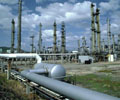Refinery margin tracker: Can diesel carry the margins as gasoline demand plummets?

Falling gasoline demand is pummeling cracking margins across the globe as the precipitous drop in business operations and normal lifestyle due to imposed quarantines from COVID-19 takes its toll on the refining complex, an analysis from S&P Global Platts showed Monday.
While price impact from the new reduced sulfur IMO bunker fuel specification has been far less than feared due to lower demand, diesel is faring better than gasoline in the low-demand environment resulting from COVID-19, despite lower jet fuel demand due to flight cancellations to prevent the spread of the virus.
“In my opinion, diesel will need to perform and carry the cracks,” said Sergio Baron, consultant with S&P Global Platts Analytics. “At the same time, jet production will be diverted to diesel pool,”
On the NYMEX, front-month RBOB cracks compared with the front-month crude contract settled at 28 cents/b on Monday, while the front-month ULSD cracks compared with the front-month crude contract was $15.26/b. This compares with settles as $6.04/b and $16.04/b on Friday, respectively.
Bank of America Merrill Lynch on Monday lowered their petroleum product crack forecasts for 2020 “due to global macro headwinds and virus quarantine measures weighing on demand.”
The bank said ULSD, RBOB and 1.0% FO to Brent cracks may average $14, $4, and $2.5/b this year, with upside versus the curve in the second half of the year.
USGC MARGINS BENEFIT SLOW OF CRUDE EXPORTS
Despite falling futures cracks and plummeting demand, US Gulf Coast refinery cracking margins were still healthy for domestic crudes.
WTI MEH cracking margins on the US Gulf Coast averaged $8.33/b for the week ended March 13, compared with the $9.66/b the week earlier, according to Platts Analytics margin data. This is due in part to a fall in exports of WTI MEH stranded in the US due to a sharp rise in global dirty tanker rates.
Global refiners flocked to Saudi Arabian crude after the Kingdom increased its production and cut its price in its bid to win back market share. This pushed up freight rates, thus eating into profit margins and dampening demand for waterborne crudes.
VLCC rates from the USGC to China more than doubled to $25.56/mt for the week ended March 13, compared with the $10.92/mt the week earlier, on increased demand for VLCCs from the Persian Gulf to China. .
VLCC rates from the Persian Gulf to China averaged $47.26/mt for the week ended March 13, compared with the $24.22/mt the week earlier, as between 70 and 80 fixtures were seen in the week.
However, other regions more dependent on waterborne crude shipments saw a drop in margins.
WTI MEH cracking margins dropped to $1.01/b in NWE, from $1.32/b the week earlier, while US Atlantic Coast cracking margins for Bonny Light fell to minus $3/b, compared with the $4.52/b the week earlier.
STOCK BUILDS LOOM AS STORAGE FILLS
Over the next few months, Platts Analytics sees global “massive” stock builds of 500 million barrels in its best case scenario, compared with the 1 billion-barrel build in its worst case scenario, relative to end February levels.
“The reality is likely to be between these cases,” said Rick Joswick, global head at oil pricing and trade flow analytics at Platts Analytics. “Although the current trajectory of the infection of infection is pointing toward the worst case, it is too early to tell whether or not that will be the most likely outcome.”
Joswick estimates the supply-demand imbalance is likely to be quite extreme, particularly in March, April and May.
He expects stocks are likely to increase at the rate of 150 million to 300 million barrels per month, but a more normal pattern in the second half of the year is assumed if the pandemic abates. If demand recovers in the second half of the year, Platts Analytics forecasts 2020 annual average demand growth of 240,000 b/d.
CHINA SLOWLY RETURNING TO MORE NORMAL OPERATIONS
China appears to returning to more normal operations, a spokesman for China’s National Health Commission said during a March 12 press conference, citing recent data trends for Hubei province and China as a whole, which support the outbreak peak in China has passed.
Its refining complex appears to be restarting as business returns to more normal parameters. After a 4 million b/d run cut in February, compared with December 2019, refinery runs are recovering, but Platts Analytics does not expect runs to exceed December levels until late summer.
“Economic conditions in China are increasing normalizing; the situation is also positive for China’s demand in the transport sector,” Platts Analytics said.
China’s Ministry of Transport data shows the number of vehicles travelling on highways as of March 12 was 15.4% higher than last year, after being down 30% in February.
More travel and increased economic activity is supporting higher margins even as refinery runs start to pick up.
Arab Light cracking margins in China averaged minus $2.32/b for the week ended March 13, compared with the minus $3.95/b the week earlier. Arab Light coking margins averaged minus $1.54/b for the week ended March 13, compared with the previous week’s minus $3.37/b.
Source: Platts

 Hellenic Shipping News Worldwide Hellenic Shipping News Worldwide, Online Daily Newspaper on Hellenic and International Shipping
Hellenic Shipping News Worldwide Hellenic Shipping News Worldwide, Online Daily Newspaper on Hellenic and International Shipping

































 PG-Software
PG-Software